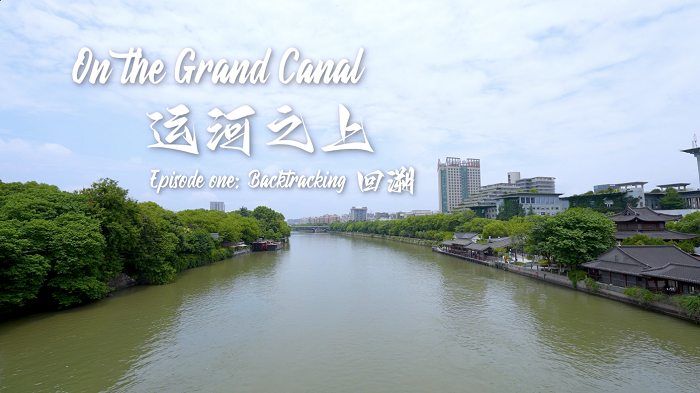Historical treasures of Grand Canal saved for next generation

The Grand Canal flows through Tongzhou district of Beijing. [Photo by Wang Danfeng/For China Daily]
Once a pivotal inland transport hub along the Beijing-Hangzhou Grand Canal, the capital is now making great strides in protecting, inheriting and utilizing the cultural significance and historical legacy associated with the Grand Canal.
Wang Youquan, director of the archaeology division at the Beijing Cultural Heritage Bureau, stated that the essence of protecting the Grand Canal's heritage is led by core world heritage sites, with an emphasis on overall and regional protection and utilization.
"The construction of the Grand Canal cultural belt and the national cultural park provide a solid foundation for the authenticity and integrity protection of world cultural heritage," he said.
Statistics show that since 2020, the Beijing Cultural Relics Bureau has organized 669 archaeological exploration projects along the Grand Canal in seven districts of the capital. These cover an area of approximately 47.54 million square meters. Three hundred and eleven excavation projects have been conducted, with an excavation area of about 32.1 million sq m.
Beijing has conducted important archaeological surveys and excavations in key sections of the Grand Canal, focusing on waterways, hydraulic relics and ancillary facilities.
For instance, in 2023, Beijing excavated southeastern relics within the ancient city site of Luxian county, covering an area of 1,500 sq m; and the foundation of Danbo Ningjing, a historical site in Beijing's Yuanmingyuan Park, revealed an architectural structure that was associated with farming, which is important for studying rice cultivation, planting, and farming techniques during the Qing Dynasty (1644-1911).
Renovation
Meanwhile, the capital has been advancing the repair of historical sites, raising the level of cultural relics protection to new heights.
Wanning Bridge in Xicheng district, a hub of the Beijing Central Axis and the Grand Canal, is a historical and cultural landmark in ancient Beijing.
In 2022, Beijing completed the first phase of its renovation, not only enhancing the protection and monitoring of the relics, but adjusting the green space on the east side of the bridge. Waterside walkways were added and the riverbank was refurbished on the west side of the bridge. In 2023, Beijing continued to remove water pipes and communication cables on the east side of the bridge, ensuring safety and improving its appearance.
Another notable site is the Pingjin sluice in the northwest of Gaobeidian village in Chaoyang district. Dating from the Yuan Dynasty (1271-1368), its head-to-head swan-wing shape, with upper and lower sluices that rise and fall alternately, solved the problem of upstream water transport. Renovation of Pingjin sluice will be completed this year.
In Changping district, the Baifu Spring, known as the water source of the Beijing-Hangzhou Grand Canal, is a popular spot for tourists. The site was listed as a cultural relic protection unit in Beijing in 1990 and as a national key cultural relic protection unit in 2013.
In 2017, Changping started clearance and renovation work at Baifu Spring, removing buildings such as hotels, villas and conference rooms that did not meet protection requirements, and repairing and protecting sites such as Donglongwang Temple, Jiulong Pond, and Baifu Spring Stele Pavilion.
In southern Beijing, after five years of major repairs, Wanshou Temple opened in 2022. It forms a large ancient architectural complex integrating a temple, garden and royal palace. Located in front of Wanshou Temple, the Guangyuan sluice is a key hub in Grand Canal cultural belt construction. Now, the newly renovated Wanshou Temple has well-arranged cypress, pine and ginkgo trees, and service facilities.
Environment
Beijing is enhancing environmental management, improving the canal ecosystem and developing cultural living areas.
In Xicheng district, Beijing's Shichahai Scenic Area, the starting point of the Tonghui River, saw the construction of a 3-kilometer lakeside walking path and the establishment of a 10.9-hectare Xihai Wetland Park in 2018. This project connects parks, cultural relics, leisure facilities and cultural spots around Shichahai, creating a lakeside scenic belt.
The Three Temples and One Tower scenic area in the Beijing Municipal Administrative Center of Tongzhou is currently the only "Confucian, Buddhist and Taoist" architectural complex in China. After comprehensive repairs and preservation of the cultural relics, the area has been upgraded to the Tongzhou Grand Canal Historical and Cultural Scenic Area.
"The number of museums along the Grand Canal has been increasing in an orderly manner, with gradually enhanced cultural interpretation capabilities. Besides traditional museums, there have also emerged 'museum-like' institutions along the Grand Canal. Since 2020, 26 new registered museums have been added, bringing the total number of registered museums along the Grand Canal in the seven districts of Beijing to 169," Wang said.
Additionally, the Grand Canal Museum of Beijing in Tongzhou has been opened to the public. The museum consists of basic exhibitions, thematic exhibitions, open displays and temporary exhibitions, covering a total area of 33,800 sq m and showcasing 6,000 sets of cultural relics.
-
Hangzhou welcomes 3.8 million tourists during Mid-Autumn Festival
September 18, 2024
-
Hangzhou's digital trade expo to be fully powered by green electricity
September 13, 2024
-
Hangzhou Paralympians return victorious from Paris
September 11, 2024



